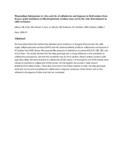| dc.contributor.author | Mberu, EK | |
| dc.contributor.author | Nzila, AM | |
| dc.contributor.author | Nduati, E | |
| dc.contributor.author | Ross, A | |
| dc.contributor.author | Monks, SM | |
| dc.contributor.author | Kokwaro, GO | |
| dc.contributor.author | Watkins, WM | |
| dc.contributor.author | Hopkins, Sibley C | |
| dc.date.accessioned | 2013-06-06T07:57:20Z | |
| dc.date.issued | 2002-07 | |
| dc.identifier.citation | Exp Parasitol. 2002 Jun-Jul;101(2-3):90-6 | en |
| dc.identifier.uri | http://www.ncbi.nlm.nih.gov/pubmed/12427462 | |
| dc.identifier.uri | http://erepository.uonbi.ac.ke:8080/xmlui/handle/123456789/28965 | |
| dc.description.abstract | We have determined the relationship between point mutations in the gene that encodes the sulfa target, dihydropteroate synthase (DHPS) and the chemosensitivity profile to sulfadoxine and dapsone in 67 isolates from Kilifi, Kenya. We assessed the presence of mutations at codons 436, 437, 540, 581, and 613 of dhps. The results showed that the dhps genotype had a strong influence on the sensitivity to sulfadoxine and dapsone, but that the correlation was far from perfect. Eleven isolates carried a wild-type dhps allele, but were resistant to sulfadoxine (IC(50) values >10 microg/ml), and 4/28 isolates were classed as sensitive to sulfadoxine (IC(50) values <10 microg/ml), but carried a triple mutant (436/437/613) allele of dhps. These data show that in low folate medium in vitro, the dhps genotype alone did not account completely for sulfadoxine or dapsone resistance; other factors such as the utilisation of exogenous folate must also be considered | en |
| dc.language.iso | en | en |
| dc.publisher | University of Nairobi. | en |
| dc.title | Plasmodium falciparum: in vitro activity of sulfadoxine and dapsone in field isolates from Kenya: point mutations in dihydropteroate synthase may not be the only determinants in sulfa resistance | en |
| dc.type | Article | en |
| local.publisher | Department of Pharmaceutics & Pharmacy Practice, Faculty of Pharmacy, College of Health Sciences | en |

